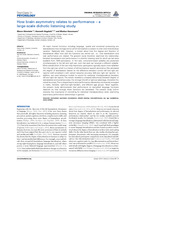| dc.description.abstract | All major mental functions including language, spatial and emotional processing are lateralized but how strongly and to which hemisphere is subject to inter- and intraindividual variation. Relatively little, however, is known about how the degree and direction of lateralization affect how well the functions are carried out, i.e., how lateralization and task performance are related. The present study therefore examined the relationship between lateralization and performance in a dichotic listening task for which we had data available from 1839 participants. In this task, consonant-vowel syllables are presented simultaneously to the left and right ear, such that each ear receives a different syllable. When asked which of the two they heard best, participants typically report more syllables from the right ear, which is a marker of left-hemispheric speech dominance. We calculated the degree of lateralization (based on the difference between correct left and right ear reports) and correlated it with overall response accuracy (left plus right ear reports). In addition, we used reference models to control for statistical interdependency between left and right ear reports. The results revealed a u-shaped relationship between degree of lateralization and overall accuracy: the stronger the left or right ear advantage, the better the overall accuracy. This u-shaped asymmetry-performance relationship consistently emerged in males, females, right-/non-right-handers, and different age groups. Taken together, the present study demonstrates that performance on lateralized language functions depends on how strongly these functions are lateralized. The present study further stresses the importance of controlling for statistical interdependency when examining asymmetry-performance relationships in general. | en_US |

